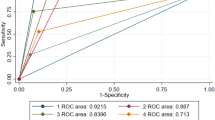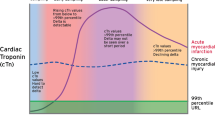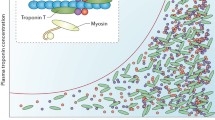Abstract
Purpose of Review
This paper will review the published literature on the implementation of high-sensitivity troponin in the diagnosis and treatment of myocardial infarction, with a special focus on accelerated diagnostic protocols used in the emergency department and other acute care settings.
Recent Findings
Since the FDA approval of high-sensitivity troponin assays in 2017, US healthcare systems have begun creating accelerated diagnostic protocols for emergency departments. Standardization of the assay can improve patient outcomes and the efficiency of emergency rooms nationwide.
Summary
This paper summarizes the historical use of the standard troponin assay and the significance of the high-sensitivity troponin assay as used in acute care settings. Implementation of the high-sensitivity troponin is discussed, demonstrating common assays used, clinical considerations, and previously reported accelerated diagnostic pathways. These aspects are aligned with current guidelines in the use of high-sensitivity troponin to emphasize the need for standardization of use within the US healthcare system.

Similar content being viewed by others
Data Availability
No datasets were generated or analyzed during the current study.
References
Papers of particular interest, published recently, have been highlighted as: • Of importance •• Of major importance
Bhat RG, Nguyen MV, Blue O, Thai HT, Cacciapuoti M, Harvey H, Spiegel R. High sensitivity troponin - six hours is the magic number. Am J Emerg Med. 2022;61:52–5. https://doi.org/10.1016/j.ajem.2022.08.037. Epub 2022 Aug 19. PMID: 36041277.
Nawar EW, Niska RW, Xu J. National hospital ambulatory medical care survey: 2005 emergency department summary. Adv Data. 2007;386:1–32. PMID: 17703794.
Anderson JL, Adams CD, Antman EM, Bridges CR, Califf RM, Casey DE Jr, Chavey WE 2nd, Fesmire FM, Hochman JS, Levin TN, Lincoff AM, Peterson ED, Theroux P, Wenger NK, Wright RS, Jneid H, Ettinger SM, Ganiats TG, Lincoff AM, Philippides GJ, Zidar JP, American College of Cardiology Foundation/American Heart Association Task Force on practice guidelines. 2012 ACCF/AHA focused update incorporated into the ACCF/AHA 2007 guidelines for the management of patients with unstable angina/non-st-elevation myocardial infarction: a report of the American College of Cardiology Foundation/American Heart Association Task Force on practice guidelines. Circulation. 2013;127(23):e663–828. https://doi.org/10.1161/CIR.0b013e31828478ac. Epub 2013 Apr 29. Erratum in: Circulation. 2013;127(24):e863–4. PMID: 23630129.
Hamm CW, Bassand JP, Agewall S, Bax J, Boersma E, Bueno H, Caso P, Dudek D, Gielen S, Huber K, Ohman M, Petrie MC, Sonntag F, Uva MS, Storey RF, Wijns W, Zahger D, ESC committee for practice guidelines. ESC guidelines for the management of acute coronary syndromes in patients presenting without persistent ST-segment elevation: the task force for the management of acute coronary syndromes (ACS) in patients presenting without persistent ST-segment elevation of the European Society of Cardiology (ESC). Eur Heart J. 2011;32(23):2999–3054. https://doi.org/10.1093/eurheartj/ehr236. Epub 2011 Aug 26. PMID: 21873419.
Kontos MC, Diercks DB, Kirk JD. Emergency department and office-based evaluation of patients with chest pain. Mayo Clin Proc. 2010;85(3):284–99. https://doi.org/10.4065/mcp.2009.0560. PMID: 20194155; PMCID: PMC2843115.
Garg P, Morris P, Fazlanie AL, Vijayan S, Dancso B, Dastidar AG, Plein S, Mueller C, Haaf P. Cardiac biomarkers of acute coronary syndrome: from history to high-sensitivity cardiac troponin. Intern Emerg Med. 2017;12(2):147–55. https://doi.org/10.1007/s11739-017-1612-1. Epub 2017 Feb 11. PMID: 28188579; PMCID: PMC5329082.
Árnadóttir Á, Pedersen S, Bo Hasselbalch R, Goetze JP, Friis-Hansen LJ, Bloch-Münster AM, Skov Jensen J, Bundgaard H, Iversen K. Temporal release of high-sensitivity cardiac troponin T and I and copeptin after brief induced coronary artery balloon occlusion in humans. Circulation. 2021;143(11):1095–104. https://doi.org/10.1161/CIRCULATIONAHA.120.046574. Epub 2020 Dec 10. Erratum in: Circulation. 2021;143(25):e1116. PMID: 33297742.
Árnadóttir Á, Falk Klein C, Iversen K. Head-to-head comparison of cardiac troponin T and troponin I in patients without acute coronary syndrome: a systematic review. Biomarkers. 2017;22(8):701–8. https://doi.org/10.1080/1354750X.2017.1335779. Epub 2017 Jun 9 PMID: 28545334.
Árnadóttir Á, Vestergaard KR, Pallisgaard J, Sölétormos G, Steffensen R, Goetze JP, Iversen K. High-sensitivity cardiac troponin T is superior to troponin I in the prediction of mortality in patients without acute coronary syndrome. Int J Cardiol. 2018;259:186–91. https://doi.org/10.1016/j.ijcard.2018.01.131. Epub 2018 Feb 4 PMID: 29477263.
Haaf P, Reichlin T, Twerenbold R, Hoeller R, Rubini Gimenez M, Zellweger C, Moehring B, Fischer C, Meller B, Wildi K, Freese M, Stelzig C, Mosimann T, Reiter M, Mueller M, Hochgruber T, Sou SM, Murray K, Minners J, Freidank H, Osswald S, Mueller C. Risk stratification in patients with acute chest pain using three high-sensitivity cardiac troponin assays. Eur Heart J. 2014;35(6):365–75. https://doi.org/10.1093/eurheartj/eht218. Epub 2013 Jul 2 PMID: 23821402.
Balk EM, Ioannidis JP, Salem D, Chew PW, Lau J. Accuracy of biomarkers to diagnose acute cardiac ischemia in the emergency department: a meta-analysis. Ann Emerg Med. 2001;37(5):478–94. https://doi.org/10.1067/mem.2001.114905. PMID: 11326184.
Weinstock MB, Weingart S, Orth F, VanFossen D, Kaide C, Anderson J, Newman DH. Risk for clinically relevant adverse cardiac events in patients with chest pain at hospital admission. JAMA Intern Med. 2015;175(7):1207–12. https://doi.org/10.1001/jamainternmed.2015.1674. PMID: 25985100.
Reichlin T, Hochholzer W, Bassetti S, Steuer S, Stelzig C, Hartwiger S, Biedert S, Schaub N, Buerge C, Potocki M, Noveanu M, Breidthardt T, Twerenbold R, Winkler K, Bingisser R, Mueller C. Early diagnosis of myocardial infarction with sensitive cardiac troponin assays. N Engl J Med. 2009;361(9):858–67. https://doi.org/10.1056/NEJMoa0900428. PMID: 19710484.
Apple FS, Sandoval Y, Jaffe AS, Ordonez-Llanos J, IFCC Task force on clinical applications of cardiac bio-markers. Cardiac troponin assays: guide to understanding analytical characteristics and their impact on clinical care. Clin Chem. 2017 63(1):73–81. https://doi.org/10.1373/clinchem.2016.255109. Epub 2016 Oct 10. PMID: 28062612.
Carlton EW, Cullen L, Than M, Gamble J, Khattab A, Greaves K. A novel diagnostic protocol to identify patients suitable for discharge after a single high-sensitivity troponin. Heart. 2015;101(13):1041–6. https://doi.org/10.1136/heartjnl-2014-307288. Epub 2015 Feb 17. PMID: 25691511; PMCID: PMC4484040.
• Chapman AR, Lee KK, McAllister DA, Cullen L, Greenslade JH, Parsonage W, Worster A, Kavsak PA, Blankenberg S, Neumann J, Sörensen NA, Westermann D, Buijs MM, Verdel GJE, Pickering JW, Than MP, Twerenbold R, Badertscher P, Sabti Z, Mueller C, Anand A, Adamson P, Strachan FE, Ferry A, Sandeman D, Gray A, Body R, Keevil B, Carlton E, Greaves K, Korley FK, Metkus TS, Sandoval Y, Apple FS, Newby DE, Shah ASV, Mills NL. Association of high-sensitivity cardiac troponin I concentration with cardiac outcomes in patients with suspected acute coronary syndrome. JAMA. 2017;318(19):1913–24. https://doi.org/10.1001/jama.2017.17488. Erratum in: JAMA. 2018;319(11):1168. Soerensen NA [corrected to Sorensen NA]. PMID: 29127948; PMCID: PMC5710293. Meta-analysis of 22,457 patient from 9 different countries sought out the optimal hs-cTnI concentration at presentation to qualify patients as low risk for acute coronary syndrome.
Armbruster DA, Pry T. Limit of blank, limit of detection and limit of quantitation. Clin Biochem Rev. 2008;29(Suppl 1):S49–52. PMID: 18852857; PMCID: PMC2556583.
Clinical and Laboratory Standards Institute. Protocols for determination of limits of detection and limits of quantitation. Approved guideline. Wayne, PA USA: CLSI; CLSI document EP17. 2004.
Apple FS, Collinson PO. IFCC task force on clinical applications of cardiac biomarkers. analytical characteristics of high-sensitivity cardiac troponin assays. Clin Chem. 2012;58(1):54–61. https://doi.org/10.1373/clinchem.2011.165795. Epub 2011 Sep 30. Erratum in: Clin Chem. 2012;58(4):796. PMID: 21965555.
Roche. Elecsys troponin T-high sensitive. 2023. Available at https://diagnostics.roche.com/global/en/products/params/elecsys-troponin-t-high-sensitive-tnt-hs.html. Accessed 20 Nov 2023.
Bandstein N, Ljung R, Johansson M, Holzmann MJ. Undetectable high-sensitivity cardiac troponin T level in the emergency department and risk of myocardial infarction. J Am Coll Cardiol. 2014;63(23):2569–78. https://doi.org/10.1016/j.jacc.2014.03.017. Epub 2014 Mar 30 PMID: 24694529.
Body R, Carley S, McDowell G, Jaffe AS, France M, Cruickshank K, Wibberley C, Nuttall M, Mackway-Jones K. Rapid exclusion of acute myocardial infarction in patients with undetectable troponin using a high-sensitivity assay. J Am Coll Cardiol. 2011;58(13):1332–9. https://doi.org/10.1016/j.jacc.2011.06.026. Erratum in: J Am Coll Cardiol. 2012;60(12):1122. PMID: 21920261.
U.S Food & Drug Administration. ARCHITECT STAT high sensitivity troponin-I 510(k) number K191595. 2019. Available at https://www.accessdata.fda.gov/cdrh_docs/pdf19/K191595.pdf. Accessed 20 Nov 2023.
Abbott. Troponin. 2023. Available at https://www.corelaboratory.abbott/us/en/offerings/segments/cardiac/troponin.html#isi. Accessed 20 Nov 2023.
Neumann JT, Sörensen NA, Ojeda F, Schwemer T, Lehmacher J, Gönner S, Jarsetz N, Keller T, Schaefer S, Renné T, Landmesser U, Clemmensen P, Makarova N, Schnabel RB, Zeller T, Karakas M, Pickering JW, Than M, Parsonage W, Greenslade J, Cullen L, Westermann D, Blankenberg S. Immediate rule-out of acute myocardial infarction using electrocardiogram and baseline high-sensitivity troponin I. Clin Chem. 2017;63(1):394–402. https://doi.org/10.1373/clinchem.2016.262659. Epub 2016 Nov 30 PMID: 27903616.
Sandoval Y, Smith SW, Shah AS, Anand A, Chapman AR, Love SA, Schulz K, Cao J, Mills NL, Apple FS. Rapid rule-out of acute myocardial injury using a single high-sensitivity cardiac troponin I measurement. Clin Chem. 2017;63(1):369–76. https://doi.org/10.1373/clinchem.2016.264523. Epub 2016 Nov 3 PMID: 27811203.
Beckman Coulter. Access high sensitivity troponin I assay. 2023. Available at https://www.beckmancoulter.com/products/immunoassay/access-hstni#/overview. Accessed 20 Nov 2023.
Beckman Coulter. Access immunoassay systems instructions for use. 2021. Available at https://www.beckmancoulter.com/download/file/phxC09449G-EN_US/C09449G?type=pdf. Accessed 20 Nov 2023.
Kim S, Yoo SJ, Kim J. Evaluation of the new Beckman Coulter Access hsTnI: 99th percentile upper reference limits according to age and sex in the Korean population. Clin Biochem. 2020;79:48–53. https://doi.org/10.1016/j.clinbiochem.2020.02.005. Epub 2020 Feb 12 PMID: 32059836.
Cook B, McCord J, Hudson M, Al-Darzi W, Moyer M, Jacobsen G, Nowak R. Baseline high sensitivity cardiac troponin I level below limit of quantitation rules out acute myocardial infarction in the emergency department. Crit Pathw Cardiol. 2021;20(1):4–9. https://doi.org/10.1097/HPC.0000000000000230. PMID: 32639243; PMCID: PMC7899745.
Siemens Healthineers. Advia centaur high-sensitivity troponin I assay. 2018. Available at https://cdn0.scrvt.com/39b415fb07de4d9656c7b516d8e2d907/1800000006781448/7dcea7abaa21/30-18-12862-01-76_ADVIA_Cntr_TNIH_Glb_SS_Fnl_1800000006781448.pdf. Accessed 20 Nov 2023.
Siemens Healthineers. Literature compendium high sensitivity cardiac troponin. 2021. Available at https://marketing.webassets.siemens-healthineers.com/7cf42d47ad8ad910/e08de0dd8978/LD_TNIH_LiteratureCompendium-2_OUS_FINAL.pdf-V7.pdf. Accessed 20 Nov 2023.
Siemens Healthineers. High-sensitivity troponin-I assay. 2023. Available at https://www.siemens-healthineers.com/laboratory-diagnostics/assays-by-diseases-conditions/cardiac-assays/high-sensitivity-troponin-i-assay. Accessed 20 Nov 2023.
Body R, Morris N, Collinson P. Single test rule-out of acute myocardial infarction using the limit of detection of a new high-sensitivity troponin I assay. Clin Biochem. 2020;78:4–9. https://doi.org/10.1016/j.clinbiochem.2020.02.014. Epub 2020 Mar 2 PMID: 32135083.
Akwe J, Hallford B, Kim E, Miller A. A review of cardiac and non-cardiac causes of troponin elevation and clinical relevance part II: non cardiac causes. J Cardiol Curr Res. 2018;11(1). https://doi.org/10.15406/jccr.2018.11.00364.
Logeart D, Beyne P, Cusson C, Tokmakova M, Leban M, Guiti C, Bourgoin P, Solal AC. Evidence of cardiac myolysis in severe nonischemic heart failure and the potential role of increased wall strain. Am Heart J. 2001;141(2):247–53. https://doi.org/10.1067/mhj.2001.111767. PMID: 11174339.
Shah ASV, Anand A, Strachan FE, Ferry AV, Lee KK, Chapman AR, Sandeman D, Stables CL, Adamson PD, Andrews JPM, Anwar MS, Hung J, Moss AJ, O'Brien R, Berry C, Findlay I, Walker S, Cruickshank A, Reid A, Gray A, Collinson PO, Apple FS, McAllister DA, Maguire D, Fox KAA, Newby DE, Tuck C, Harkess R, Parker RA, Keerie C, Weir CJ, Mills NL, High-STEACS Investigators. High-sensitivity troponin in the evaluation of patients with suspected acute coronary syndrome: a stepped-wedge, cluster-randomised controlled trial. Lancet. 2018;392(10151):919–28. https://doi.org/10.1016/S0140-6736(18)31923-8. Epub 2018 Aug 28. PMID: 30170853; PMCID: PMC6137538.
• Anand A, Lee KK, Chapman AR, Ferry AV, Adamson PD, Strachan FE, Berry C, Findlay I, Cruikshank A, Reid A, Collinson PO, Apple FS, McAllister DA, Maguire D, Fox KAA, Newby DE, Tuck C, Harkess R, Keerie C, Weir CJ, Parker RA, Gray A, Shah ASV, Mills NL, HiSTORIC Investigators†. High-sensitivity cardiac troponin on presentation to rule out myocardial infarction: a stepped-wedge cluster randomized controlled trial. Circulation. 2021;143(23):2214–24. https://doi.org/10.1161/CIRCULATIONAHA.120.052380. Epub 2021 Mar 23. PMID: 33752439; PMCID: PMC8177493. Randomized control trial including emergency departments of 7 acute care hospitals enrolling 31,492 patients to demonstrate safety and efficacy of early rule-out pathways for patients presenting with suspected acute coronary syndromes.
Apple FS, Fantz CR, Collinson PO; IFCC committee on clinical application of cardiac bio-markers. implementation of high-sensitivity and point-of-care cardiac troponin assays into practice: some different thoughts. Clin Chem. 2021:67(1):70–8. https://doi.org/10.1093/clinchem/hvaa264. PMID: 33279984; PMCID: PMC7799201.
Stepinska J, Lettino M, Ahrens I, Bueno H, Garcia-Castrillo L, Khoury A, Lancellotti P, Mueller C, Muenzel T, Oleksiak A, Petrino R, Guimenez MR, Zahger D, Vrints CJ, Halvorsen S, de Maria E, Lip GY, Rossini R, Claeys M, Huber K. Diagnosis and risk stratification of chest pain patients in the emergency department: focus on acute coronary syndromes. A position paper of the Acute Cardiovascular Care Association. Eur Heart J Acute Cardiovasc Care. 2020;9(1):76–89. https://doi.org/10.1177/2048872619885346. Epub 2020 Jan 20. PMID: 31958018.
Chapman AR, Hesse K, Andrews J, Lee KK, Anand A, Shah ASV, Sandeman D, Ferry AV, Jameson J, Piya S, Stewart S, Marshall L, Strachan FE, Gray A, Newby DE, Mills NL. High-sensitivity cardiac troponin I and clinical risk scores in patients with suspected acute coronary syndrome. Circulation. 2018;138(16):1654–65. https://doi.org/10.1161/CIRCULATIONAHA.118.036426. PMID: 30354460; PMCID: PMC6200389.
•• Writing Committee; Kontos MC, de Lemos JA, Deitelzweig SB, Diercks DB, Gore MO, Hess EP, McCarthy CP, McCord JK, Musey PI Jr, Villines TC, Wright LJ. 2022 ACC expert consensus decision pathway on the evaluation and disposition of acute chest pain in the emergency department: a report of the American College of Cardiology Solution Set Oversight Committee. J Am Coll Cardiol. 2022;80(20):1925–60. https://doi.org/10.1016/j.jacc.2022.08.750. Epub 2022 Oct 11. PMID: 36241466. 2022 American College of Cardiology guidelines for the evaluation of chest pain in the emergency department provide a comprehensive review of current definitions, findings, and recommended evaluation of chest pain.
• Gulati M, Levy PD, Mukherjee D, Amsterdam E, Bhatt DL, Birtcher KK, Blankstein R, Boyd J, Bullock-Palmer RP, Conejo T, Diercks DB, Gentile F, Greenwood JP, Hess EP, Hollenberg SM, Jaber WA, Jneid H, Joglar JA, Morrow DA, O'Connor RE, Ross MA, Shaw LJ. 2021 AHA/ACC/ASE/CHEST/SAEM/SCCT/SCMR guideline for the evaluation and diagnosis of chest pain: a report of the American College of Cardiology/American Heart Association Joint Committee on clinical practice guidelines. Circulation. 2021;144(22):e368–454. https://doi.org/10.1161/CIR.0000000000001029. Epub 2021 Oct 28. Erratum in: Circulation. 2021;144(22):e455. PMID: 34709879. 2021 guidelines for diagnosis of chest pain including comprehensive literature search provide an evidence-based approach to risk stratification and diagnostic workup for the evaluation of chest pain.
Lowry MTH, Anand A, Mills NL. Implementing an early rule-out pathway for acute myocardial infarction in clinical practice. Heart. 2021;107(23):1912–9. https://doi.org/10.1136/heartjnl-2019-316242. Epub 2021 Sep 3. PMID: 34479874; PMCID: PMC8600603.
Roffi M, Patrono C, Collet JP, Mueller C, Valgimigli M, Andreotti F, Bax JJ, Borger MA, Brotons C, Chew DP, Gencer B, Hasenfuss G, Kjeldsen K, Lancellotti P, Landmesser U, Mehilli J, Mukherjee D, Storey RF, Windecker S, ESC Scientific Document Group. 2015 ESC guidelines for the management of acute coronary syndromes in patients presenting without persistent ST-segment elevation: task force for the management of acute coronary syndromes in patients presenting without persistent ST-Segment elevation of the European Society of Cardiology (ESC). Eur Heart J. 2016;37(3):267–315. https://doi.org/10.1093/eurheartj/ehv320. Epub 2015 Aug 29. PMID: 26320110.
Backus BE, Six AJ, Kelder JC, Bosschaert MA, Mast EG, Mosterd A, Veldkamp RF, Wardeh AJ, Tio R, Braam R, Monnink SH, van Tooren R, Mast TP, van den Akker F, Cramer MJ, Poldervaart JM, Hoes AW, Doevendans PA. A prospective validation of the HEART score for chest pain patients at the emergency department. Int J Cardiol. 2013;168(3):2153–8. https://doi.org/10.1016/j.ijcard.2013.01.255. Epub 2013 Mar 7 PMID: 23465250.
Carlton EW, Khattab A, Greaves K. Identifying patients suitable for discharge after a single-presentation high-sensitivity troponin result: a comparison of five established risk scores and two high-sensitivity assays. Ann Emerg Med. 2015;66(6):635–45.e1. https://doi.org/10.1016/j.annemergmed.2015.07.006. Epub 2015 Aug 7 PMID: 26260100.
Jaeger C, Wildi K, Twerenbold R, Reichlin T, Rubini Gimenez M, Neuhaus JD, Grimm K, Boeddinghaus J, Hillinger P, Nestelberger T, Singeisen H, Gugala M, Pretre G, Puelacher C, Wagener M, Honegger U, Schumacher C, Moreno Weidmann Z, Kreutzinger P, Krivoshei L, Freese M, Stelzig C, Dietsche S, Ernst S, Rentsch K, Osswald S, Mueller C. One-hour rule-in and rule-out of acute myocardial infarction using high-sensitivity cardiac troponin I. Am Heart J. 2016;171(1):92–102.e1–5. https://doi.org/10.1016/j.ahj.2015.07.022. Epub 2015 Jul 26. PMID: 26699605.
Author information
Authors and Affiliations
Contributions
E.B. wrote the main manuscript, prepared all figures and tables, and reviewed the manuscript.
Corresponding author
Ethics declarations
Conflict of Interest
The author declares no competing interests.
Human and Animal Rights and Informed Consent
This article does not contain any studies with human or animal subjects performed by any authors.
Additional information
Publisher's Note
Springer Nature remains neutral with regard to jurisdictional claims in published maps and institutional affiliations.
Rights and permissions
Springer Nature or its licensor (e.g. a society or other partner) holds exclusive rights to this article under a publishing agreement with the author(s) or other rightsholder(s); author self-archiving of the accepted manuscript version of this article is solely governed by the terms of such publishing agreement and applicable law.
About this article
Cite this article
Burke, E. Current Evidence for the Use of High-Sensitivity Troponin Assays in the Emergency Department. Curr Emerg Hosp Med Rep 12, 13–21 (2024). https://doi.org/10.1007/s40138-024-00282-x
Accepted:
Published:
Issue Date:
DOI: https://doi.org/10.1007/s40138-024-00282-x




